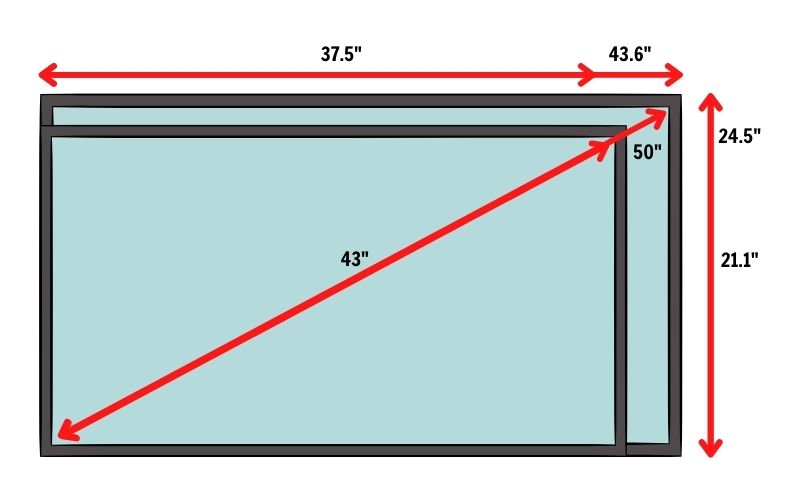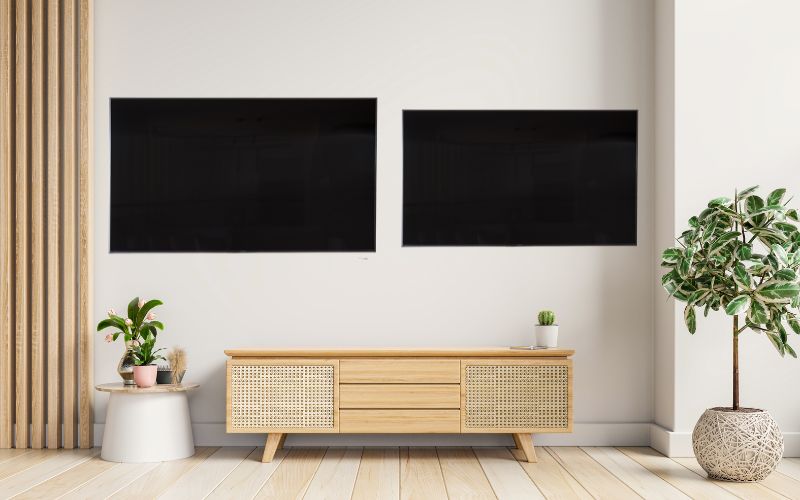Choosing the right size TV for your home can be difficult since you can’t always visualize how a screen will look when it’s in place. And it can be hard to know which is the right size you should be aiming for, and do they all have the same features?

It’s a little bit of a minefield, but I’m here to make things a little bit easier. I’ll explain to you the differences between the sizes of these two TV screens, as well as give you a rundown of other features you might want to consider. By the end, you’ll have a much clearer picture (pun intended) of which one is right for you.
What is the size difference between a 43-inch and 50-inch TV?
The size difference between a 43-inch TV and 50-inch TV is pretty substantial. Measuring from corner to corner, a 50-inch TV is 7 inches larger, which means it’s both taller and wider too. A 50-inch TV is considered a large screen TV, though there are now many that are bigger.
Bigger doesn’t necessarily mean better though, and there are a few things to consider when you’re deciding which TV to buy, which I’m going to delve into further throughout this guide. But as a quick overview, you’ll want to think about where your TV is going to live, how far you’ll be sat from it, and the features available.
Some quick context is important too. 50-inch screens were, for a few years, considered to be one of the most popular screen sizes. They broke new ground for large screen TVs, whereas previously 40-inches was seen as being impressive.
But over time, as manufacturing methods have changed and costs are going down, it’s been easier and easier to produce bigger TVs. And at the same time, the 43-inch screen has become a lot more popular, since it fills the gap for a mid-sized TV but sounds a lot more impressive than the old 40-inch standard.
Now, you’ll actually find that 43-inch TVs tend to be more common than 50-inch ones. If you want to make the jump up from a 43-inch TV then 55 inches tends to be the more common choice.
Read more: 50-inch vs 55-inch TVs
43-inch And 50-inch TV Dimensions
Here’s how a 43-inch and a 50-inch TV measure up:
| TV size | Corner to corner | Height | Width | Area |
|---|---|---|---|---|
| 43-inch | 43 inches | 21.1 inches | 37.5 inches | 791.25 square inches |
| 50-inch | 50 inches | 24.5 inches | 43.6 inches | 1,068.2 square inches |
This diagram shows you how these measurements compare. A 43-inch TV is quite a lot smaller than a 50-inch one – it’s around 3.4 inches shorter, and 6.1 inches more narrow. If you were to upgrade from a 43-inch TV to a 50-inch one then you’d definitely notice the difference.

How much bigger is a 50-inch TV than a 43-inch?
A 50-inch TV is 3.4 inches taller and 6.1 inches wider than a 43-inch TV, which gives a difference of almost 277 square inches of screen space. That’s almost an extra 2 square feet of screen, which can really make the difference when you want that big screen experience.
Of course, that might make a 50-inch TV too big for what you need. Despite what TV manufacturers tell you, bigger isn’t always better. It depends on the room that you’ll be using it in, and how far from the screen you’ll be sitting.
43 Vs 50 Inch TVs Side By Side
Side-by-side the difference between a 43-inch TV and a 50-inch TV is pretty stark. The 50-inch TV dwarfs the 43-inch model, with that extra height and width creating an overall screen size that’s much bigger.
Remember that it’s worth considering the bezel too since that can add a couple of inches in each direction. But neither 43-inch TVs nor 50-inch TVs tend to be in that premium range where the bezel is almost non-existent, and so it’s not likely to have an impact on a direct comparison between the two.

Should you buy a 43-inch or 50-inch TV?
There are a number of factors to consider when deciding between a 43-inch TV and a 50-inch one. If you want the big screen experience, you have to choose 50-inches. But for a bedroom TV, or one with better features, a 43-inch TV is likely to be more suitable.
Let’s take a look at some of those factors which will influence your decision.
Price
Comparing the price of TVs isn’t straightforward, because a lot of 50-inch TVs are surprisingly basic when it comes to features. And a lot of 43-inch TVs are packed with cool tech. So it’s not unusual to find a 50-inch TV that could be half the price (or even better) of some 43-inch models.
But if you do compare like-for-like when it comes to tech, then a 43-inch will be cheaper than a 50-inch. When you boil it down to basics, bigger screens that have the same features cost more than smaller ones. You could probably get a basic 43-inch 4K TV for around $80-100 less than a similar 50-inch model.
But the price range of a 43-inch TV varies wildly. A simple model that’s got a Full HD resolution might cost $200 or so, while the best TVs might cost around $1,500.
SAMSUNG 43-Inch QLED 4K Smart TV

- Enjoy vivid, lifelike color, regardless of brightness from 100% Color Volume with Quantum Dot
- Elevate your space with a sleek TV aesthetic
- Alexa built-in
SAMSUNG 50-Inch QLED 4K Smart TV

- Enjoy vivid, lifelike color, regardless of brightness from 100% Color Volume with Quantum Dot
- Elevate your space with a sleek TV aesthetic
- Alexa built-in
Availability
Availability is a big consideration, especially if you like to buy your TV from a specific brand or manufacturer. A lot of TV manufacturers have either stopped making 50-inch TVs, or they’re only introducing a limited range in that size. Instead, 55-inch has become the mid-range TV size of choice.
There are still a handful of Samsung TVs in 50-inches, but Sony and LG models are very rare. Meanwhile, 43-inch TVs are still very popular as that low-mid size screen, and so there’s a lot more choice when you’re shopping at this screen size.
Having said that, if you do want a budget TV that’s a bit smaller, it may be better to aim for a 40-inch model instead. The difference between 40-inch and 43-inch TVs is minimal, and while 40-inch screens are also not as widely available, they are still made by some of the budget manufacturers and so prices can be very low.
Size and viewing distance
There are a few more points to make on the size of these TVs which may influence your decision.
Firstly, you’ll want to think about viewing distance. A 43-inch TV is best viewed from 6 feet away, while a 50-inch TV’s optimum viewing distance is 7 feet. It’s a marginal difference, but those are the optimum distances. If you’re going to be sat 5.5 feet from the screen, or 7.5 feet, then the choice becomes more stark.
Also, where is the TV going to live? For a living room, a 50-inch screen would probably be preferred unless your couch is close to where the TV will be located, but most bedrooms will work better with a 43-inch model.

A lot of gamers are adopting high-end 43-inch models for their setup too, choosing them over dual monitors or ultra-wide displays. A 50-inch wouldn’t suit this because it’s too big, you’d spend all day moving your neck to take everything in.
And finally, if you plan on placing the TV on a stand, check the feet. If it has a central stand then it will likely be fine, but a 50-inch TV with separate feet at each end may not fit on your furniture. Each TV is different when it comes to the distance between feet, so you’ll have to check the spec before you buy.
Features
Choosing a TV isn’t just about the size, but it’s also about how good the TV is. And the decision between these two screen sizes can get a little confusing.
Let’s start with resolution. Every 50-inch TV is going to be a 4K one, so that’s simple. With a 43-inch TV, most are 4K now but there are still some 1080p Full HD options if you’re on a budget.
The screen type is where the biggest difference is going to be made in picture quality though, and it’s here where things get muddled. There are standard LED screens in both sizes, and you can get a 43-inch and a 50-inch QLED too.
If you want a Mini LED TV, like a Samsung Neo QLED, then you’ll have to choose a 50-inch TV. But most people prefer an OLED, and they’re only available in 43-inches, or 48-inches just to confuse things even more.
As well as LG’s OLED, there are also a number of specialty TVs in the 43-inch range. Samsung is known for them in particular – they have The Frame, which is a TV that has a special matte screen that displays artwork when you’re not watching the TV.

The Frame
And they have the Sero, an unusual TV that rotates 90 degrees and is designed for mirroring your phone screen.

Sero
43-inch TVs tend to have better gaming features too, often having HDMI 2.1 ports with 4K/120fps support.
Broadly speaking, you’ll find a wider range of cool picture tech (and sound tech too) if you opt for a 43-inch TV. Most 50-inch TVs are relatively simple, except for a handful of Samsung options.
The Best 43- To 50-Inch TV For The Money
If you’re looking for a TV for your living room, and you want the best bang for your buck, then this Amazon Fire TV is a great choice. It’s a 50-inch TV that costs a lot less than some of the best 43-inch models, and while the picture quality isn’t amazing it does have a 4K resolution, multiple HDR formats for brighter, realistic colors, and plenty of smart features.
Amazon Fire 50-Inch 4-Series 4K UHD Smart TV

- Delivers a clearer and more vibrant picture with brighter colors compared to 1080p Full HD
- Alexa skills, features, smart home capabilities, and voice functionality
- Bring movies and shows to life with support for vivid 4K Ultra HD, HDR 10, HLG, and Dolby Digital Plus
The Bottom Line
Making a single recommendation for a TV when deciding between a 43-inch and 50-inch model is difficult. The best 43-inch TVs will cost a lot more than most 50-inch TVs because they’re packed with amazing tech to bring movies and shows to life.
But they’re only really a great size for bedrooms. For most living rooms, you’ll want that big screen experience that you get from a 50-inch TV or bigger.
However, if you’re really energy conscious, you might want to check out the consumption of TVs too – after all, a smaller screen could save you some pennies every year.
Read more: How much electricity does a TV use?
